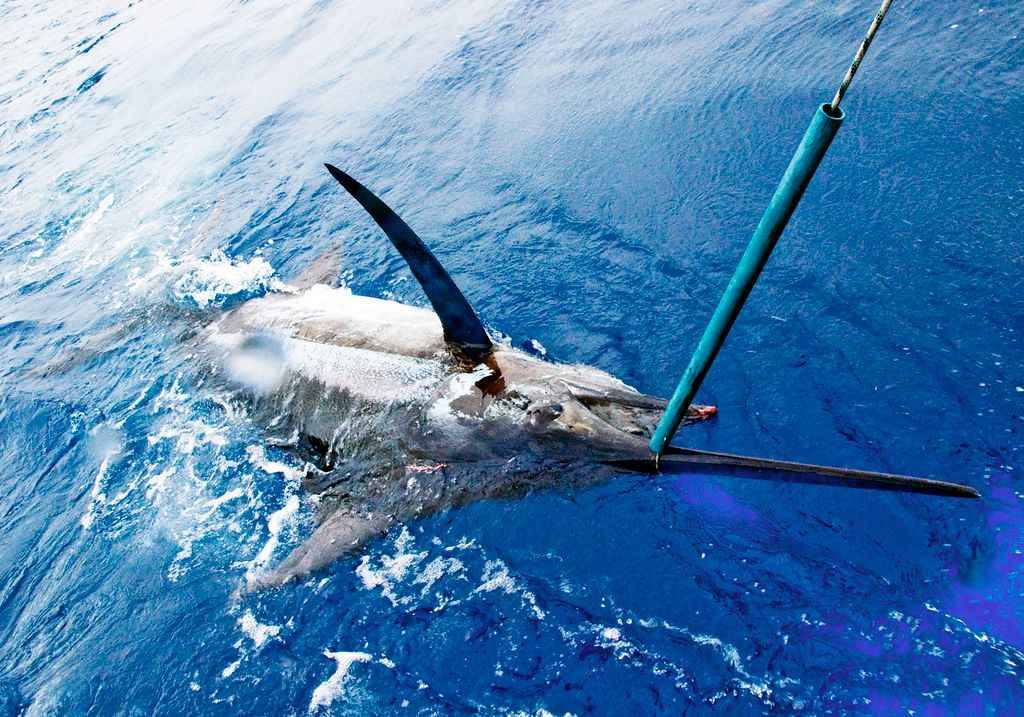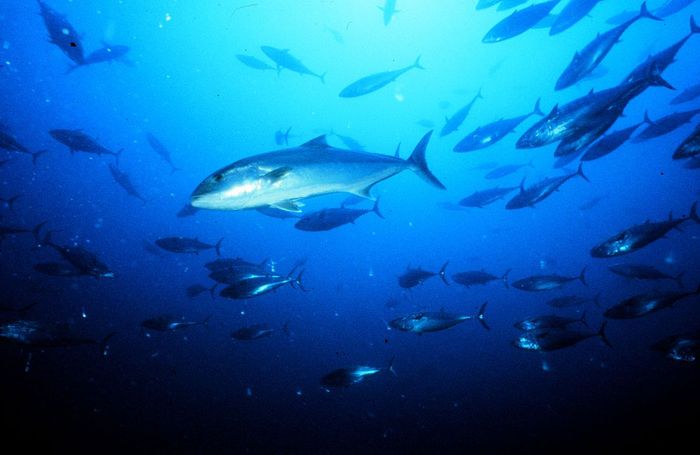9 Most Difficult Fish to Catch in Florida
See if your favorite fish makes it to our extensive list of the 9 most difficult fish to catch in Florida.

For any angler, there is nothing more satisfying for any angler Therethan catching a difficult game fish, and it is quite possibly the penultimate goal of anybody who’s held a rod and reel. Florida has such various species that narrowing this list down to nine fish was a challenge in itself. This list was based on two factors - the elusiveness of fish and how much of a fight it can put up. Here are the nine most difficult fish to catch in Florida.
1.Blue marlin
Don’t act surprised that this fish is the first on our list. Inarguably the most prized sport fish, the blue marlin is a formidable foe. It’s massive, difficult to find, and will put up an enormous fight. These 800-pound acrobatic beasts have hard mouths, making the hook difficult to set, and their bills are a force to be reckoned with. Catching the blue marlin is a battle of endurance and strength, making it one of the top trophy fish in Florida and the world.

To catch this blue beast, you’ll want to head out to the Lower Keys. Around 20 miles south of Key West, Wood’s Wall or The Wall is known for where the ocean floor drops off to almost 2,000 feet in depth. Marlin marauders eyeing for tournament trophies often slow-troll the area with large live baits such as blackfin tuna from July to October.
Other hotspots in the Keys include Little Torch Key, Key Largo, Big Pine Key, and the infamous Islamorada. While anywhere along the offshore coasts of Florida is good for a chance at the blue marlin, the Panhandle region, such as Destin, in October has been known to be a favorite of local anglers as well.

2. Greater amberjack
Mostly found around large structures such as reefs, wrecks, and oil rigs, the amberjack is known for aggressively and quickly attacking anything you throw in its presence. Once it’s snagged your bait, it will swiftly retreat into its home, pulling your line against the rough surfaces of structures. The “Reef Donkey”, as it’s known locally, is a specialist at diving and navigating its home, so the first 30 seconds of your battle are critical in not snapping your line. Be prepared for sore muscles and an aching back after battling the amberjack. You might even be knocked off your feet as you fight it out with this fast and powerful fish.
Many of the International Game Fish Association (IGFA) records for the greater amberjack have been caught in Florida, with the All-Tackle World Record for length caught off Key West, measuring at 140 cm (55in). It’s not hard to find the AJ around the Gulf Coast since they have been known to come near the shore, but warm waters around 200-300 feet deep near oil rigs are known to be one of its favorite spots.

3. Bonefish
The Grey Ghost is an elusive target and is one of the smallest fish that are difficult to catch. They are fast, finicky, and can appear invisible in the water due to their silvery blue-green skin, making it a great challenge for anglers. Known for their lightning-fast first runs that can reach 40 miles an hour, the bonefish can pull a line with the same force as a fish twice its size. While it’s not difficult to find it in the shallow flats, it’s tough to trick bonefish to bite your lure or bait. Anglers have been known to go home empty-handed when hunting the bonefish.
If you want to go ghost hunting, you’ll want to go to the flats of Key West starting in May as the water becomes warmer, where individuals are known to reach up to 12 pounds. The IGFA All-Tackle record for length was caught in Elliott Key, measuring 21 inches (53 cm). You can also catch them during their migration run along Islamorada, and the Marquesas Islands are also known for their bonefish numbers. There are endless expansive flats in Miami where you can duke it out with the bonefish. Stiltsville on the edge of Biscayne Bay is known for its shallow, clear waters, making it easier to hunt for bonefish.
4. Permit
Permit have strong sickle-shaped caudal fins and muscular bodies, the perfect build for a tough fight. This fish is notorious for its unpredictability and skittishness. It’s known to prefer offshore wrecks, but when they travel to the shallows to feed, they are extra wary. This fish has excellent eyesight and will often swim right past your lure or bait, even if you present right in front of it. Once it’s hooked, the permit will nose-dive to the bottom and swim erratically, so be prepared with a line that can withstand abrasion against coarse structures.
Part of the Florida Key Grand Slam, permit are found all around South Florida and the Keys year-round, but is best during spring and autumn anywhere from Biscayne Bay to Key West, and Florida Bay.
5. Crevalle jack
The crevalle jack is a fighter, a strong swimmer, and has great endurance. This fish will pull hard when hooked, and you can expect a long fight ahead. Even the juvenile jack crevalle can put up a worthy fight against veteran anglers. It has a muscular body with a forked tail that allows it to swim hard. This fish schools in large aggregations, which can add to its aggressiveness when competing for food, and have been the culprit of many feeding frenzies. The Palm Beaches and Key West are famous for their trophy Crevalles, especially during the spring and fall. Jacks have a wide range, but their preference for warmer waters is what draws them down South.
6. Tarpon
The Silver King is on every angler’s bucket list. These beautiful, ancient, and majestic creatures are known for their aerial displays and the sound their flapping gills make when putting up a fight. The tarpon has a hard mouth and sharp teeth, making them even more difficult to hook. It’s one thing to hook this shimmering beauty and another matter to bring them in since this fish is notorious for escaping a hook. The tarpon will twist, turn, and leap out of the water as high as 10 feet. Anglers shouldn’t try to overcome the Silver King and wait patiently until they get exhausted and roll on their side.
On the west coast, Boca Grande is known as the “Tarpon Capital of the World”, with its shallow flats around Crystal River, Homosassa Bay, and Apalachicola Bay that is best during the summer. In the Keys, some notable spots include Long Key, Seven Mile Bridge, Bahia Honda Bridge, and Marquesas Keys from May to July, while the Key West Harbor is best earlier from January to March. If you’re in Miami, Government Cut is definitely the place to go. This human-made strip of water between the city’s beach and Fisher Island is best in the later afternoon and evenings. Since tarpon prefer currents, the ends of the month from April to June are best.
It can get quite crowded in these areas, so anglers that want a more peaceful experience may want to check the Ten Thousand Islands with endless shallow flats for the silver king to swim in. However, the water is not as clear due to the inflow from the Everglades.
7. Sailfish
The sailfish is South Florida’s pride and joy, with several tournaments dedicated to this lightning-fast game fish. Known for their dorsal fins that run along the length of their streamlined body, sailfish have hard bills that are difficult to hook. This fish puts up a fight with fantastic aerial displays, and anglers can only hold on and wait for it to become exhausted before reeling them in. Sailfish are primarily found offshore at the edges of reefs but have been known to visit South Florida in waters a mere 30 feet deep. If you’re going after this streamlined swimmer, you’ll want to go to Sailfish Alley. Traversing the lengths of Treasure Coast, this prime spot runs from Fort Pierce all the way down to St. Lucie Inlet and Stuart, which has been named the “Sailfish Capital of the World”.
8. Wahoo
The wahoo is one of the fastest fish in the ocean, reaching speeds of 50 miles/hour. This “torpedo with fins” can easily drag meters of your line out in the blink of an eye. It has beautiful striped patterns and razor-sharp teeth, which gives anglers quite a challenge in hooking this aquatic missile. Mostly found around wrecks, floating debris, and in offshore waters, the wahoo is known to school along offshore banks as well.
Wahoo are plentiful in Key West year-round, but November through February are when their numbers increase near the reefs. East Coast Florida anglers suggest that the full moons during July and August along the shores of Florida is the best time.
9. Swordfish
Finding a swordfish is half the battle, as these large fish spend most of their time are in offshore waters from 1800 to 5000 feet deep. It will surface when feeding at night when it’s usually caught, but anglers can hook one during the day using breakaway rigs and heavy weights. Its flattened bill is used to slice at its prey, so expect your bait to be cut up. Swordfish have excellent eyesight and are unbelievably strong, fast, and known for their acrobatic leaps.
The eastern coast of Florida in the offshore waters of Palm Beach County and down south by Islamorada are some of the best areas to look for swordfish. Pompano Beach currently holds the IGFA W-04 kg (8lb) Line Class record at 58.33 kg (128 lb 9 oz).
No matter which fish you target from this list, always check laws and regulations. Check the size and bag limits, catch-and-release fisheries, and any permits that you may need. Once you’re fully compliant, you can head out there and catch that prized game fish.




